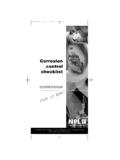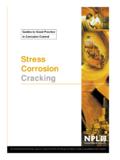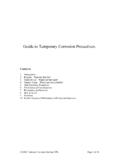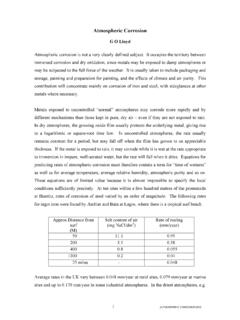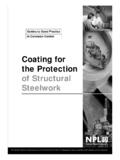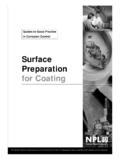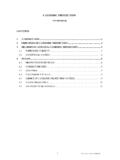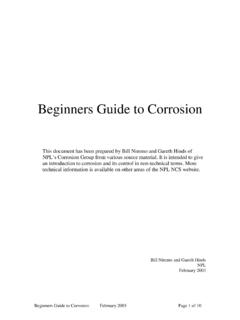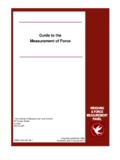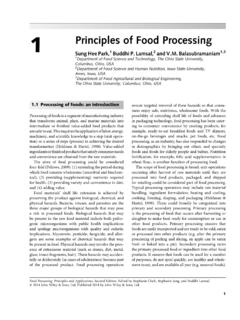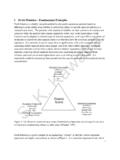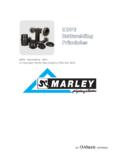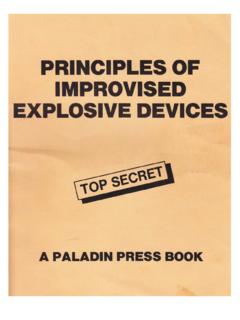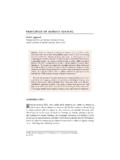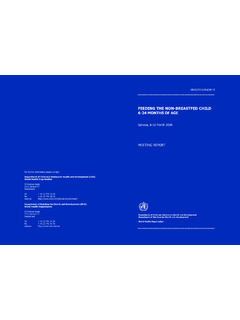Transcription of The Beginner’s Guide to Temperature Measurement
1 Good Practice Guide No. 125 The beginner s Guide to Temperature MeasurementRichard Rusby1 Measurement Good Practice Guide No. 125 The beginner s Guide to Temperature Measurement Richard Rusby National Physical Laboratory 2 Queen s Printer and Controller of HMSO, 2012. ISSN 1368-6550 September 2012 National Physical Laboratory Teddington, Middlesex, United Kingdom, TW11 OLW Extracts from this report may be reproduced provided the source is acknowledged and the extract is not taken out of context. 3 NPL Measurement Good Practice Guides This is one of a series of NPL guides about Measurement .
2 These guides are aimed at everyone who has an interest in Measurement , whether in a laboratory, factory, hospital, university, college or in any other walk of life. The series includes beginner s guides, which introduce Measurement concepts, methods and practices at a basic level. More specialised guides cater for Measurement professionals and practicing scientists and engineers who want to go more deeply into an area of Measurement . References to additional guides or reading are given where appropriate. All these guides aim to promote good practice in Measurement , and are produced with technical input from specialists in the particular subject covered.
3 NPL is the UK s national Measurement institute. It aims to deliver the highest economic and social benefits through world-leading and responsive science and knowledge services. This series of NPL Good Practice Guides provides one way to transfer knowledge to people who need to make better measurements. For more information or help with Measurement problems visit 4 Introduction to Measurement Measurement underpins science, technology and industry. It enables processes to be run efficiently, and innovative and competitive products to be made. It impacts strongly on the welfare of a modern society and touches almost every aspect of daily life.
4 A Measurement tells us about a property of something. It might tell us how heavy an object is, or how hot, or how long it is. A Measurement gives a number to that property, expressed in the appropriate unit. The units of Measurement are standardised. The International System of Units (SI) is used worldwide so that measurements can be consistent everywhere. Measurements are only ever estimates. Every Measurement is subject to some uncertainty. Perfect measurements cannot be made and so the true value is never known exactly. The uncertainty of a Measurement expresses how good the estimate is thought to be.
5 A Measurement result is incomplete without a statement of uncertainty. It is therefore in three parts: a number, a unit of Measurement , and an uncertainty. For example, a length may be measured as cm + cm. The uncertainty of a Measurement should suit the need: a school clock need not have atomic accuracy. Measuring equipment should be calibrated by comparison against a suitable reference which itself has been calibrated. An unbroken chain of calibrations linking back to a national standards body such as the National Physical Laboratory (NPL) is known as Measurement traceability. Good Measurement practice can reduce uncertainty and so improve the quality of processes and products.
6 5 A beginner s Guide to Temperature Measurement Contents Introduction to Measurement .. 4 0 About this Guide .. 7 1 Introduction .. 7 What is Temperature ? .. 7 Why measure Temperature ? .. 8 Basic questions in Temperature Measurement .. 9 Temperature units and the International Temperature Scale of 1990 10 Fixed points .. 11 12 2. Contact thermometers and their calibration .. 13 Resistance thermometers .. 13 Thermocouples .. 15 Calibration .. 17 3. Non-contact thermometry .. 19 Infrared radiation thermometers .. 19 Blackbody 24 Choosing and using infrared thermometers: coping with emissivity. 25 Thermal imaging and thermography.
7 27 4. Contact Temperature measurements in practice .. 29 Measurements in 29 Measurements in air and other 30 Measurements in solids .. 31 Measurements on surfaces .. 31 Industrial measurements and standards .. 33 Temperature measurements in healthcare .. 34 Choosing the right Temperature sensor .. 37 5. Further reading .. 38 6 7 0 About this Guide This is an introductory Guide which aims to help first-time users who have no experience of how to measure Temperature beyond what they may have picked up in school, college or everyday life. The range of potential applications in science and technology, at low and high temperatures , is very broad and none can be treated in detail, but it is hoped that after reading this Guide the user will feel more confident in approaching the task and will find the literature more accessible.
8 1 Introduction The Guide opens with some basic background to the concept of Temperature , why it is important to measure it, and some of the difficulties which may be encountered. Perhaps the first question for a new user to consider is whether to use a contact method, in which a sensor is inserted or attached to the object or medium whose Temperature is to be measured, or whether to use a remote sensing non-contact method. Contact methods are introduced in Section 1. They mostly use electrical sensors such as resistance thermometers, for applications requiring good accuracy up to moderately high temperatures (usually <450 C, but sometimes higher).
9 Alternatively thermocouples are smaller, more rugged and durable, and can be used at much higher temperatures , but are less accurate. These sensors are discussed in Section 2. Guidance about how to use them is given in Section 4. Non-contact infrared radiation thermometry is discussed in Section 3. It is well adapted for measuring very hot, moving or distant objects, and so avoids many of the problems of using contact sensors, but it also has its disadvantages. The basic principles of the method are outlined, and some guidance is given about choosing and using an infrared thermometer. What is Temperature ?
10 Modern ideas about heat and Temperature go back to the mid-nineteenth century when it was first realised that heat is the energy associated with the motion of the atoms or molecules of which everything is made. The more energetic the atoms are, the faster they move (in a gas or liquid) or the more vigorously they vibrate (in a solid). Temperature is related to heat but is different from it. As we all know, the application of heat causes the Temperature to rise except that when the heat melts a solid or boils a liquid, the Temperature remains constant! 8 We can easily see that heat and Temperature are different because the heat energy in a large object is greater than that in a small object of the same material at the same Temperature .
